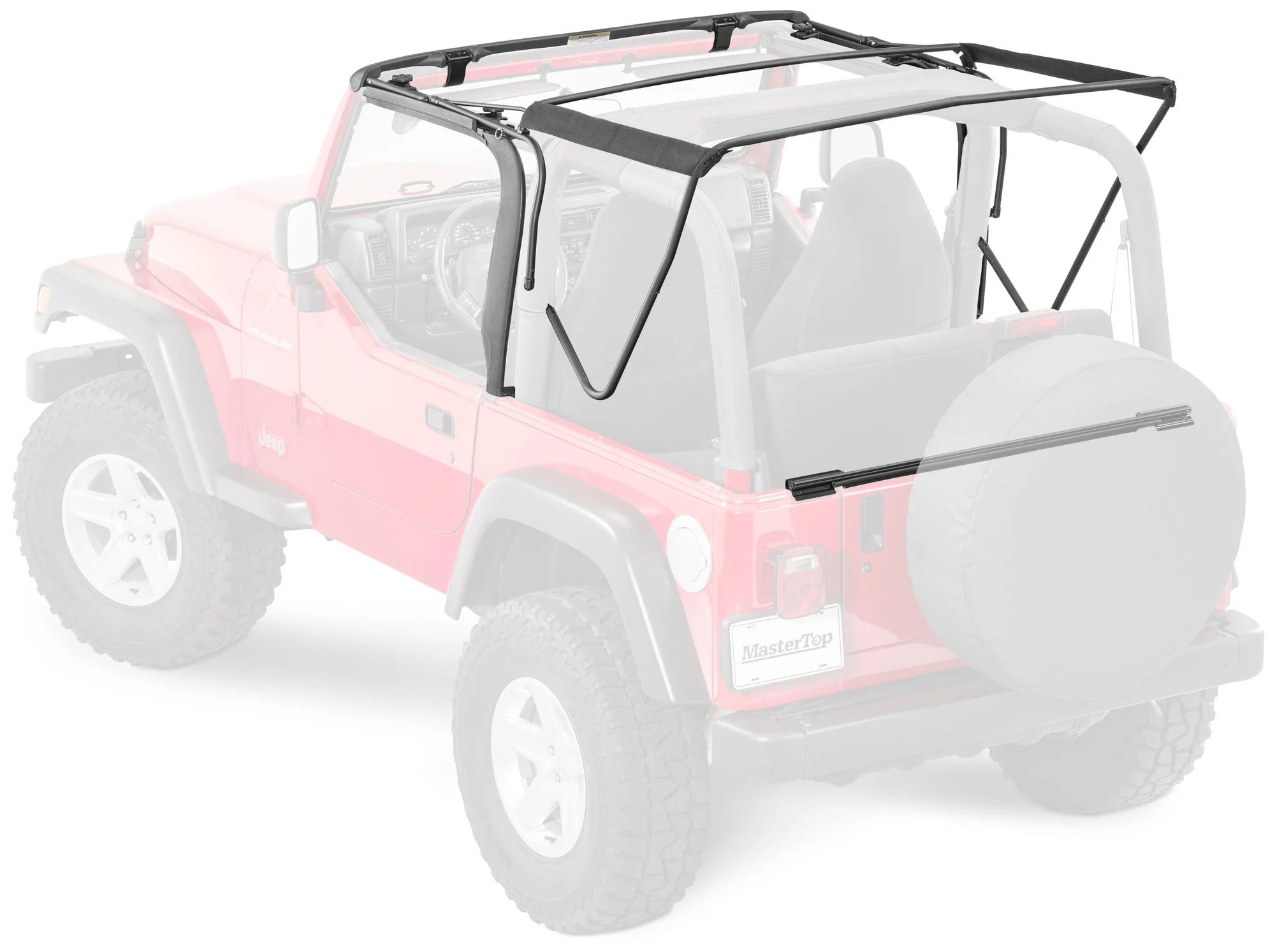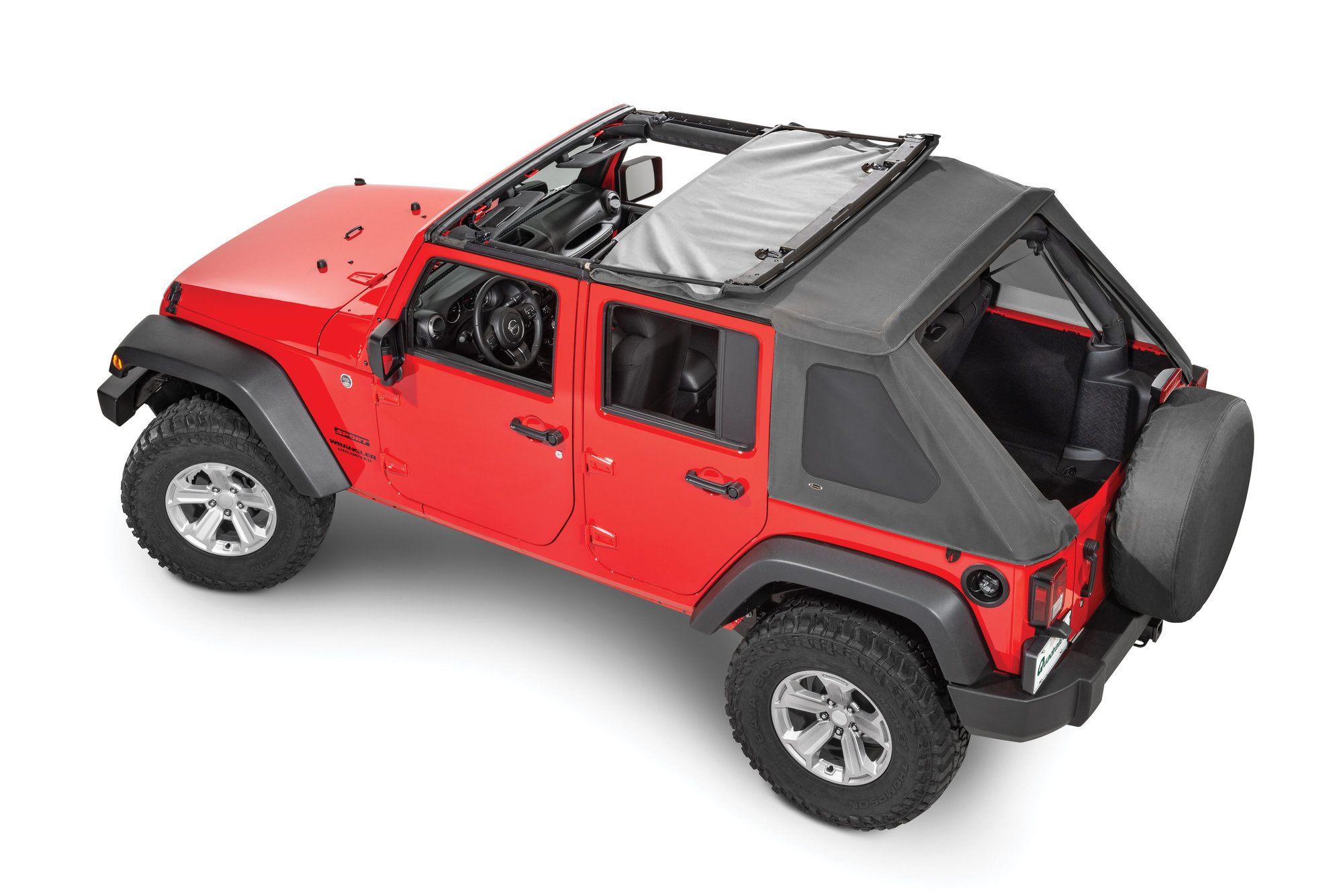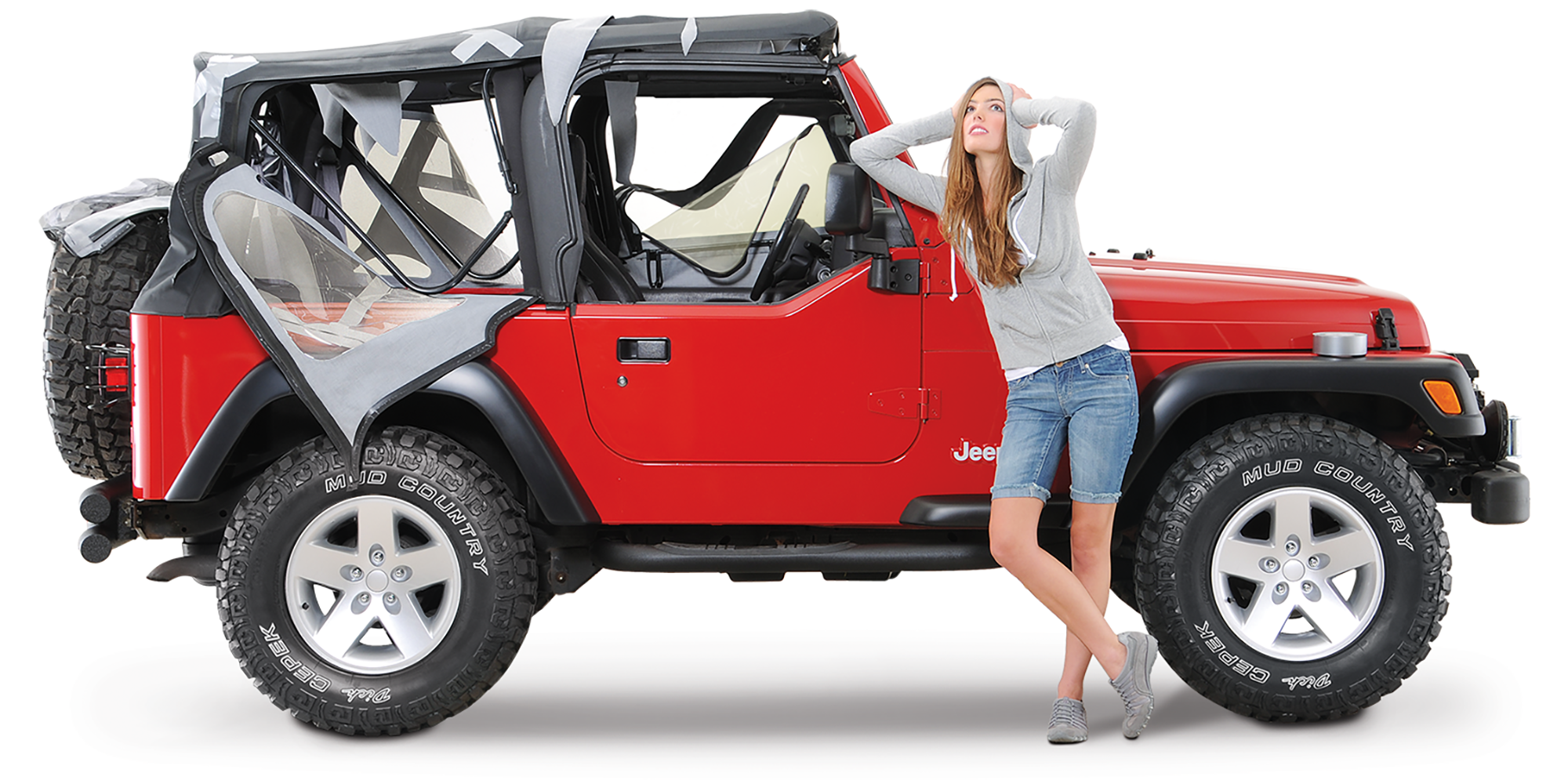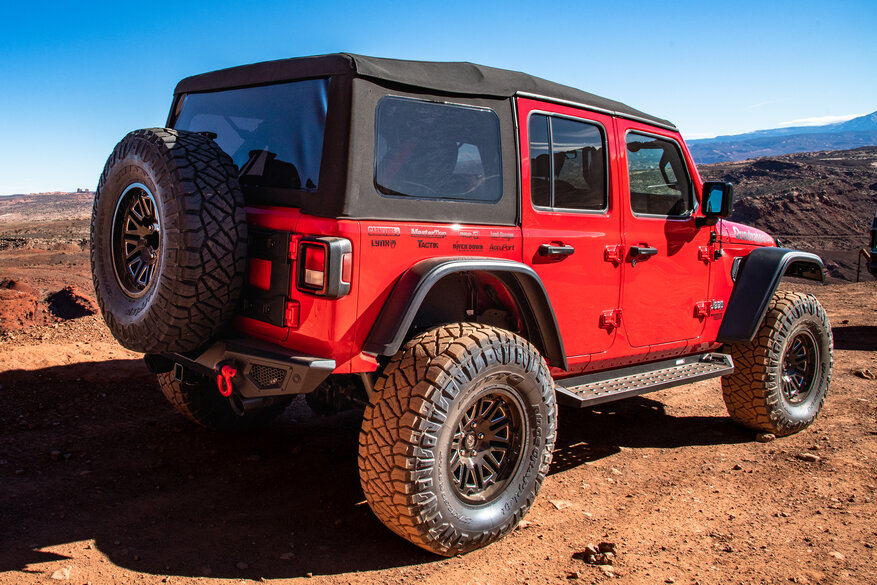by Matt Konkle
Managing Editor
There is something about a soft top that just enhances the Jeep life. Maybe it is the whole appearance aspect and how it really looks different than pretty much anything else on the road. Maybe it is the ability to quickly fold down for an entire open cab experience — something that harkens way back to the original topless design. And maybe it is simply the whisper of adventures to come, flittering across the canvas material and beckoning drivers to get in, power up and discover something new under a sunbaked sky.
Whatever the reason, soft tops have been a foundation of Jeep vehicles for decades. Top up, top down — it is always ready for anything.
Nothing against a hardtop because it has its place as well for some people, but when that beautiful summer day comes along, and you can easily remove soft top windows while reclining that material, well, it makes the whole Jeep experience a bit more memorable.
Still, many take pause when thinking about outfitting their Jeep with a soft top. Especially if it is the first one they’ve ever used. So questions no doubt rise. Are these tops durable? What about using during the winter? Is it loud inside the vehicle?
Well, if you are someone in that category and are debating on a soft top for your new Wrangler, or simply inherited one with a used vehicle and want to know more, here are some common soft top questions and answers we’ve been repeatedly asked over 30-plus years.
What is a Jeep soft top?
A Jeep soft top is simply the canvas ‘roof’ that protects the interior of your vehicle. It includes the deck, which is the main fabric piece, as well as two rear quarter windows and a rear window. Some tops, depending on the Jeep, may have front upper fabric doors as well.
They also have the ability to fold back above the tailgate to expose the cabin on nice weather days, giving occupants a convertible-type fresh-air feel.
Jeep soft tops are an easy way to enjoy the outdoors while still being protected from the elements and are constructed from durable fabric that can withstand the rigors of off-road, as well as daily driving.
What are the benefits of Jeep soft tops?
Jeep soft tops offer many benefits over hardtop-equipped vehicles. They are much lighter and easier to remove, which makes them ideal for taking on and off-road adventures. They also provide better ventilation and allow you to enjoy the scenery more when you're driving. And because they fold down, they're much easier to store when not in use.
Additionally, Jeep soft top side and rear windows can be removed while the top remains on the vehicle, providing another nice way to enjoy a driving experience.

How do I know a Jeep soft top will fit my vehicle?
Depending on the model year of your Jeep, there should be plenty of soft top choices. And one of the quickest ways to know if a top will fit is understanding what year you have, whether the top is complete with cloth and hardware and is designed to fit that specific model.
Tops that include everything mean you do not have to know exactly what you currently have on the Jeep, as everything will be replaced. This is a great option for those with hardtops, or those with broken soft top hardware, ripped material, or nothing at all on the vehicle.
If you do have a soft top on the Jeep right now, and it utilizes the factory original hardware bow system, then a replacement top is your best option. These tops are more affordable as they just replace the fabric on your vehicle and directly attach to your current hardware system.
However, if your factory hardware is old, rusted, bent, difficult to fold up or down, or you are simply unsure if it is even the factory stuff, then please use our soft top advisor to help determine your needs.
What are the different types of Jeep soft tops
As Jeep has evolved over the years, so has the soft top offerings for the vehicle.
These days, there are factory-style replacement tops that come with all-new hardware systems and may also include front windows depending on the vehicle, slant back (or fastback) style tops that change the rear appearance of the Jeep by sloping the back window into the tailgate and replacement tops that simply attach to your current hardware system.
Here is more information each of those versions:
How do I know which Jeep soft top is right for me
The best way to determine which Jeep soft top is right for you is simply to consider your needs and preferences. If you rarely drive the vehicle, then you most likely do not need a super-thick twill top with all-new hardware. Instead, more economical fabric versions exist that can connect to your current hardware.
Determining the right Jeep soft top for you also can be influenced by what system you currently have on the Jeep, as some tops do not work with factory systems. Others include all-new stuff for those with broken parts or destroyed fabric/windows. Some even ditch the hardware and go straight frameless.
Once again, the best advice is really to decide how much you actually rely on the Jeep, what you currently have on the vehicle and then research a soft top that has the strength to fill those needs.
And the best place to start is pulling up our soft top advisor.
What is the difference between a Jeep hardtop and a Jeep soft top
Jeep hardtops are made from a rigid material, such as fiberglass, that makes the vehicle more in tune with what many expect from a regular car. That solid roof helps mute road noise and provides additional security. However, they are also quite a bit more tricky to remove should you want to enjoy a nice open cabin, and you can run into storage issues should you fully remove from your Jeep. Hardtops are generally more expensive than soft tops, either when purchasing a new vehicle or replacing another top.
Meanwhile, like we said earlier, Jeep soft tops are made from a flexible fabric that generally attaches to a hardware system that allows the top to fully cover the Jeep, or easily fold down when the weather cooperates. These tops also include two side windows and a rear window that secure with zippers or a track system depending on your Jeep’s year.
Soft tops provide easier access to open air and do not need to be removed from the vehicle to enjoy a nice warm day. Most hardtops do have front removable panels, but the overall top removal process is much more difficult, and normally requires the help of friends or a hardtop hoist system.
Is a Jeep soft top safe?
There is nothing inherently unsafe about a Jeep soft top. The vehicle’s roll cage, plus airbags, will protect you if something should happen on- or off-road. Additionally, soft tops are waterproofed so you are secure against rain and snow. Plus, they retain heat well in the winter so you won’t freeze when the weather turns cold.
Many tops these days also use a thicker fabric so there is reduced wind noise while driving, which also makes them more durable and protective over time versus previous generation tops.
Is a Jeep top secure?
While fabric soft tops do run the risk of being cut easier than other types of tops, there are plenty of studies that show most vehicle break-ins happen because of unlocked doors — regardless of top.
Many Jeep soft tops also utilize side and rear windows that are tinted, which helps obscure visibility into the cabin. But no matter the top, it always makes sense not to leave anything valuable inside the vehicle that could entice someone to try and steal. Also, there are many companies that make lockable center consoles, underseat storage units or overhead shelf systems that provide a great way to secure your stuff when you are not in the Jeep.
How long do Jeep soft tops last?
The life expectancy of a soft top really is really determined by how much you drive the vehicle as well as the quality of the material. Obviously the thinner that material, the faster it can wear down through constant use. Thicker fabric like sailcloth and twill will last substantially longer. Generally, as a daily driver, a Jeep soft top will average about three to five years.

What are some Jeep soft top features?
Jeep soft tops come with a variety of features that offer numerous benefits.
The first is ease of use. Jeep soft top windows can zip or slide out of tracks in seconds, while the top can fully recline on nice days so you can quickly enjoy that open cab experience without having to worry about finding enough storage space.
Another is convenience. You can do anything you need to a soft top without involving assistance from another person, and the entire thing can be pulled up or down in seconds — a nice benefit when there is impending nasty weather. Plus, the convenience of a pull-down top allows you to connect to nature in a way that is almost unlike any other vehicle.
Next, Jeep soft tops are usually more affordable than hardtops, and there are plenty of options to help customize to your driving needs. As you can purchase to work with your existing factory hardware, even the best soft tops with the most durable twill material will often be substantially less money than a hardtop.
Fourth is waterproof and heat-retention construction. Although a Jeep soft top utilizes fabric, the material is entirely waterproof so it is leak proof throughout the year. In winter, it also retains heat so you do not have to worry about drastic temperature changes while driving.
Finally — simplicity of replacement. When your factory top ages past its prime, there are replacements versions that exactly match the same hardware mounting points. Additionally, side and rear windows will fit the same as well and often can be purchased separately if you just need to replace the top’s window system.
How do I install a Jeep soft top
The answer really depends on your current top. Factory tops with intact hardware systems simply can swap out the fabric and windows as everything will attach in the same locations — making the entire process streamlined and less involved.
Full top changeovers, for example those going from a hardtop to a soft top, or fully removing the current soft top and adding a complete new kit, are a bit more involved. These require installation of a new hardware system and bolting it to the vehicle, then attaching the material to mounting locations on the hardware system. While there is usually no drilling involved, it helps to have a basic understanding on shop tools to accomplish the installation.
How do I clean my Jeep soft top?
While you can purchase a Jeep soft top and then never mess with it again, a soft top should really be cleaned regularly to keep the material in pristine shape. This means either using a mild soap and water solution to clean the fabric, or specialized soft top cleaner. These cleaners are strong enough to remove soils, stains and mildew without affecting the top material. Regular water can be used to wash off the soap or cleaner, but make sure not to use a high-pressured spray as that could damage the material.
When drying the top, you can let it sit in sunlight without any issue, but a better way to finish the job is using a wet/dry vacuum and/or a microfiber drying cloth.
One thing to note, it is usually best to wash the top, and your Jeep, in a self-service car wash instead of an automatic one.
How much do Jeep soft tops cost?
Jeep soft tops vary in price depending on the fabric quality as well as the features you desire such as tinted windows, front upper doors and a hardware system.
For example, a basic replacement top designed to fit your current hardware system may only run $200-$350, however that may not be the best for your needs if the Jeep is a daily driver. That’s because the entry-level material can wear out faster through constant use.
Thicker material tops made of factory-grade Sailcloth or ultra-durable Twill material generally can run from $600-$1200 depending on the brand and window inclusion. These tend to be the most popular replacement tops as they offer the best durability for the price, and work with your current hardware system.
For those with hardtops who want to swap, or are in need of a full replacement soft top because of damaged hardware, replacement versions can run from around $600 all the way to around $2,700 depending, once again, on window types as well as fabric and hardware material quality.

What should I do if my Jeep soft top is damaged
The most common issue with a Jeep soft top is window zippers as these can break teeth or separate from the deck over time. The material can sometimes be resewn if the damage is minor, but often this will require a new rear window set. Should this be the case, it is important to know if the top is factory, factory-equivalent, or aftermarket as replacement window kits do vary based on the top. Additionally, some more economical tops do not have a replacement window option because of zipper construction as scoop counts must match from new windows to the top.
Another issue can be with windows becoming cloudy or scratched over time. This is a simple solution as there are window cleaners and polishers available that can clear up even the most difficult scratches. However, make sure to do this either in a warm garage during colder months, or outside during nice spring or summer days. This way, you will avoid
Should the deck become damaged, it will most likely need replacement with new material, however, once again, you’ll need to determine if your hardware system will support that material, or if you’ll have to go with a complete replacement.
Recommended Reading:
What Are The Differences Between A Jeep Soft Top And Hardtop?





















